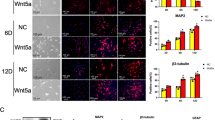Abstract
An emerging paradigm in the treatment of stroke in patients with fixed neurologic deficits is stem cell therapy. Mesenchymal stem cells (MSCs) are attractive candidate cells for transplantation because they enhance endogenous repair systems, and the process is highly feasible. In order to further understand the complexity of the biochemical and physiological changes that occur after treatment with human MSCs (hMSC) in a rat model of stroke, we performed proteomic analysis of three groups: sham group, transient middle cerebral artery occlusion (tMCAo) group, and hMSC treated tMCAo group. Using 2-dimensional electrophoresis (2-DE) and matrix-assisted laser desorption/ionization-time of flight-mass spectrometry (MALDI-TOF-MS), we identified 14 proteins with altered expression patterns among the treatment groups. Differential protein expression was confirmed by western blotting. Two proteins that were upregulated in both the tMCAo group and the hMSC treated tMCAo group relative to sham were annexin A3 and GRP78, proteins involved in angiogenesis and neuroprotection. Two proteins that were elevated in the tMCAo group relative to the sham group and recovered to normal levels in the hMSC treated tMCAo group were synaptosomal-associated protein-25 (SNAP-25) and transitional endoplasmic reticulum ATPase, proteins involved in neuron loss and apoptosis. Our results revealed differential proteomic profiles that characterize the brain of the hMSC transplanted MCAo rat. These proteomic profiles contribute to the understanding of the mechanisms underlying the efficacy of MSC in stroke therapy.
Similar content being viewed by others
References
M Kim, KH Kim, SR Park, et al., Mesenchymal Stem Cells for Treatment of Neurological Disorders: a Paracrine Effect, Tissue Eng Reg Med, 10, 234 (2013).
Y Li, J Chen, XG Chen, et al., Human marrow stromal cell therapy for stroke in rat: neurotrophins and functional recovery, Neurology, 59, 514 (2002).
LH Shen, Y Li, J Chen, et al., Intracarotid transplantation of bone marrow stromal cells increases axon-myelin remodeling after stroke, Neuroscience, 37, 393 (2006).
WY Li, YJ Choi, PH Lee, et al., Mesenchymal stem cells for ischemic stroke: changes in effects after ex vivo culturing, Cell Transplant, 17, 1045 (2008).
MJ Paik, WY Li, YH Ahn, et al., The free fatty acid metabolome in cerebral ischemia following human mesenchymal stem cell transplantation in rats, Clin Chim Acta, 402, 25 (2009).
YJ Choi, WY Li, GJ Moon, et al., Enhancing trophic support of mesenchymal stem cells by ex vivo treatment with trophic factors, J Neurol Sci, 298, 28 (2010).
JS Lee, JM Hong, GJ Moon, et al., A long-term follow-up study of intravenous autologous mesenchymal stem cell transplantation in patients with ischemic stroke, Stem Cells, 28, 1099 (2010).
OY Bang, JS Lee, PH Lee, et al., Autologous mesenchymal stem cell transplantation in stroke patients, Ann Neurol, 57, 874 (2005).
JD Kocsis, O Honmou, Bone marrow stem cells in experimental stroke, Prog Brain Res. 201, 79 (2012).
HO Kim, SM Choi, HS Kim, Mesenchymal stem cell-derived secretome and microvesicles as a cell-free therapeutics for neurodegenerative disorders, Tissue Eng Reg Med, 10, 93 (2013).
S Chen, FF Lu, P Seeman, et al., Quantitative proteomic analysis of human substantia nigra in Alzheimer’s disease, Huntington’s disease and Multiple sclerosis, Neurochem Res, 37, 2805 (2012).
DM Short, ID Heron, JL Birse-Archbold, et al., Apoptosis induced by staurosporine alters chaperone and endoplasmic reticulum proteins: Identification by quantitative proteomics, Proteomics, 7, 3085 (2007).
H Chen, M Chopp, ZG Zhang, et al., The effect of hypothermia on transient middle cerebral artery occlusion in the rat, J Cereb Blood Flow Metab, 12, 621 (1992).
A Gorg, C Obermaier, G Boguth, et al., The current state of two-dimensional electrophoresis with immobilized pH gradients. Electrophoresis, 21, 1037 (2000).
JE Park, DH Lee, JA Lee, et al., Annexin A3 is a potential angiogenic mediator, Biochem Biophys Res Commun, 337, 1283 (2005).
MJ Crumpton, JR Dedman, Protein terminology tangle, Nature, 345, 212 (1990).
Y Ye, HH Meyer, TA Rapoport, The AAA ATPase Cdc48/p97 and its partners transport proteins from the ER into the cytosol, Nature, 414, 652 (2001).
Y Li, J Chen, XG Chen, et al., Human marrow stromal cell therapy for stroke in rat: neurotrophins and functional recovery, Neurology, 59, 514 (2002).
H Ishimaru, F Casamenti, K Ueda, et al., Changes in presynaptic proteins, SNAP-25 and synaptophysin, in the hippocampal CA1 area in ischemic gerbils, Brain Res, 903, 94 (2001).
N Abumaria, R Rygula, U Havemann-Reinecke, et al., Identification of genes regulated by chronic social stress in the rat dorsal raphe nucleus, Cell Mol Neurobiol, 26, 145 (2006).
K Kurozumi, K Nakamura, T Tamiya, et al., Mesenchymal stem cells that produce neurotrophic factors reduce ischemic damage in the rat middle cerebral artery occlusion model, Mol Ther, 11, 96 (2005).
M Nieto-Sampedro, R Lim, DJ Hicklin, et al., Early release of glia maturation factor and acidic fibroblast growth factor after rat brain injury, Neurosci Lett, 86, 361 (1988).
A Zaheer, JL Weiss, P Goyal, et al., Enhanced expression of neurotrophic factors by C6 rat glioma cells after transfection with glia maturation factor., Neurosci Lett, 265, 203 (1999).
N Hotta, M Aoyama, M Inagaki, et al., Expression of glia maturation factor beta after cryogenic brain injury, Brain Res Mol Brain Res, 133, 71 (2005).
Author information
Authors and Affiliations
Corresponding author
Rights and permissions
About this article
Cite this article
Li, W.Y., Jin, R.L., Hu, X.Y. et al. Proteomic analysis of ischemic rat brain after human mesenchymal stem cell transplantation. Tissue Eng Regen Med 11, 333–339 (2014). https://doi.org/10.1007/s13770-014-0048-1
Received:
Revised:
Accepted:
Published:
Issue Date:
DOI: https://doi.org/10.1007/s13770-014-0048-1




